Multi-dimensional Intervention:
Reflections and Practices on Chinese Rural Architecture
Author: Hu Zhile, Zheng Andy
In contemporary China, the topic of "rural construction" has become a recurring theme in various domains. The interplay of political, cultural, productive, and commercial forces and resources has engendered a complex web of relationships that continues to shape the dynamic interactions between urban and rural areas.
If we were to summarize the relationship between urban and rural areas, it is evident that, in terms of development, rural areas always remain at a disadvantage in comparison to urban areas. Moreover, rural areas inevitably suffer from the cultural impact of urban culture, and the diversity of business formats in rural areas pales in comparison to that of urban areas.
In the present context, the issue of "rural construction" has become increasingly significant. This is primarily due to the historical overemphasis on urban development, which has led to an imbalanced and even confrontational relationship between urban and rural areas. However, people have now belatedly realized that the development of urban and rural areas cannot be separated from each other - without a healthy and functioning rural area as a reserve force, cities will face dual pressures from a continuously increasing population and the difficulty in accessing raw resources. Additionally, the high-output and fast-turnover development model in urban areas has intensified competition, which has drawn attention to the natural resources and development potential of rural areas. Furthermore, the high-density and high-pressure urban lifestyle has prompted people to reevaluate the meaning of rural living: if "Urban Disease"① is an incurable ailment, perhaps the only way to alleviate it is to escape the city, even if it is only temporarily.
In the past few decades, the prevailing understanding of urban-rural relations has been dominated by a binary opposition, resulting in excessive admiration for cities and arbitrary treatment of rural areas. We have witnessed the proliferation of urban-style development spreading to the countryside, resulting in peculiar landscapes in the so-called "Desakotas"(城乡结合部)② and "Themed Towns"(特色小镇)③,which are neither urban nor rural. Moreover, due to the rapid development of some cities, rural areas that were originally distributed on the outskirts of cities have been instantly enveloped within the city limits, becoming "Urban Villages"(城中村)④ that exist outside of the urban system. [1] Meanwhile, resource-poor rural areas are struggling to find their appropriate place within China's grand layout of development, and even basic subsistence issues are difficult to address, let alone retaining young people in the villages.

The urban village located in Futian, Shenzhen © Alessandro Zanoni.
In recent years, architects who attempt to explore rural culture through architectural approaches have collaborated with rural governments, developers, and investors to create many projects that seek to explore new rural concepts in the current era. However, the nature of these projects - whether they represent a regeneration of rural culture, an experimental pursuit of fashion, or the urban population's imposition of nostalgia on rural life - remains to be explored. The difficulties architects encounter when seeking design concepts in rural areas are undeniable. It must be recognized that urbanization is an irreversible development process. Under this premise, what does rural space mean? Is it an untapped primitive land or a secluded paradise in need of revitalization? How should the relationship between rural and urban areas be established? Should they be treated as mutually exclusive or integrated organically? Architects who fail to consider these questions as starting points for their design thinking may ultimately fail to address the real issues and even cause damage to the truly valuable rural culture.
"Rural development" is a critical social issue not only in China but also in other parts of the world. It is worth noting that the expanding metropolises worldwide share similarities in both social organization and physical form, and even tend to converge over time. However, the relationships between rural areas and their neighboring cities differ significantly across regions, and even among nearby villages in the same area. As such, the "rural problem" is difficult to address comprehensively, as each village is a unique case. This complexity poses a challenge to initiating a discussion on rural development, as efforts to establish "Model Villages"(模范村)⑤ that aim to explore a universal development approach often fail and lead to the over-concentration of resources in a single location. [2] This challenge also highlights the need to approach rural development issues from a localized, multi-dimentional perspective.
For this reason, the present moment may be the best time to pay attention to rural architecture, as effective rural development strategies have yet to be fully formed, but many rural areas worldwide have already conducted various new rural construction practices, which can provide us with some starting points and case studies to contemplate rural construction problems. However, some of the existing rural practices are still immature, and exploring future-appropriate strategies should begin by confronting these insufficient outcomes.
1.Transplantation and Mutation
It must be acknowledged that some Chinese rural areas have long been plagued by the problem of transplanting urban development models - the direct use of urban real estate experience to construct high-density buildings in rural areas. This phenomenon is the result of complex underlying causes, but it has led to rural areas becoming a muted form with an urban appearance but lacking urban lifestyles.
The "Village Consolidation"(合村并居)⑥ policy, which was introduced in Shandong in 2019, involves demolishing farmers' houses and merging existing villages to concentrate farmers in high-rise buildings similar to those found in urban areas. The policy was initially intended to help address the high operational costs, high proportion of hollow villages, and high infrastructure construction costs associated with village-level organizations. However, in practice, it has led to strong resistance and repulsion. For example, farmers are accustomed to living in single-story houses, which can accommodate agricultural machinery, various farm tools, and harvested crops, but living in high-rise buildings is very inconvenient. Additionally, farmers are now further away from their farmland, requiring long journeys back and forth for work. Many villagers prefer to build temporary sheds next to their farmland rather than live in seemingly more modern high-rise buildings. [3]
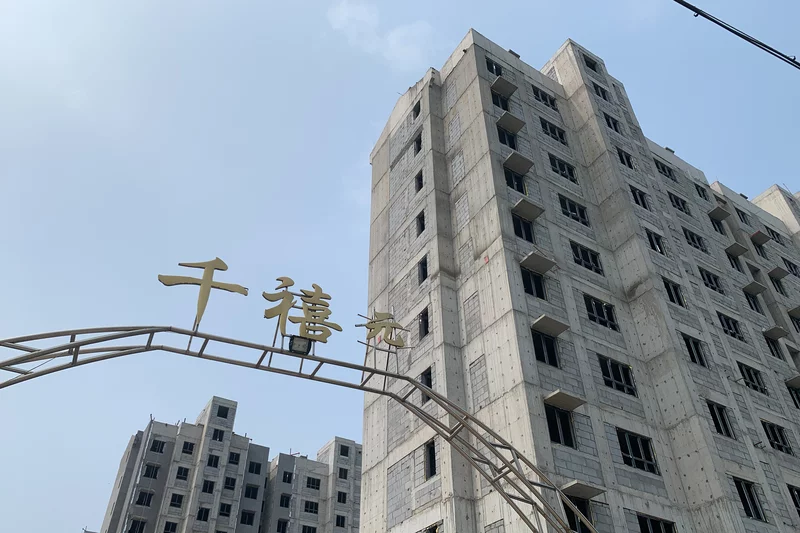
In 2020, a rural high-rise was under construction in the countryside of Heze City, Shandong Province © Amy Cheng/NPR.
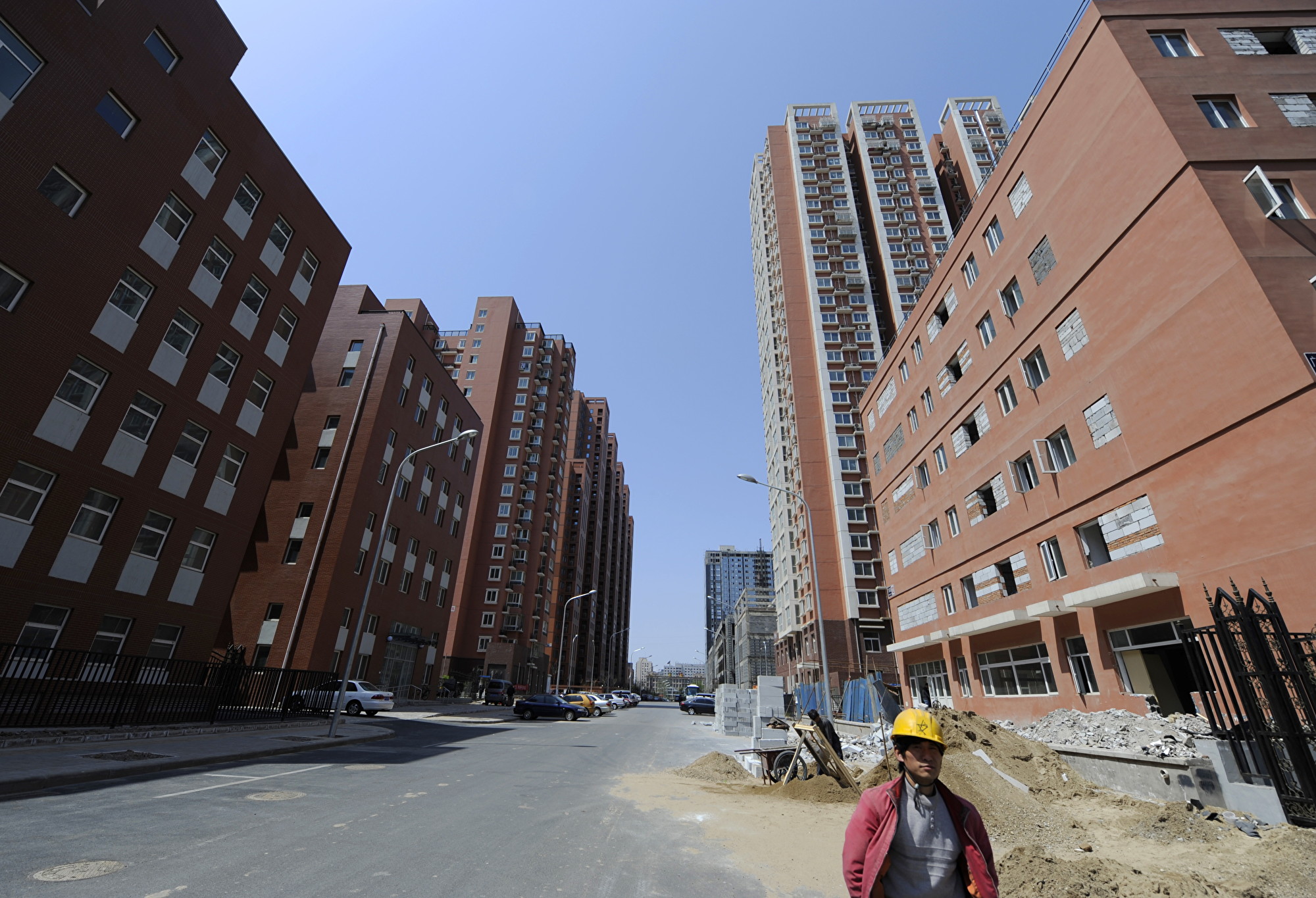
A pilot project for "merging villages and towns" in Henan, China © Internet
This example cautions us that when exploring means to revitalize rural areas, it is crucial to recognize the fundamental distinctions between rural and urban areas and to approach research from divergent perspectives. Rural and urban areas differ greatly in terms of population and construction density, and their distinct ways of life and work result in vastly contrasting physical spatial characteristics. Cities are high-density, high-efficiency production and exchange centers. The spatial and temporal dimensions of urban life are closely related - people spend time on transportation to change their geographic location, so their experience of space is point-like. In contrast, rural areas are low-density, slow-paced, and close to nature. Rural buildings are loosely connected with each other and strongly connected with farmland and the natural environment, so people's work and spatial experiences are more continuous and less bound by time. Understanding these differences, we can clearly distinguish the inappropriateness of projects like "Village Consolidation" - they do not follow the most basic rules of urban and rural construction, and urban models cannot become templates or goals for rural development. Therefore, architects also need to be aware that their architectural practice experience, which is habitually developed in cooperation with urban developers, may not be applicable to rural design, and it may even be incompatible.
As the momentum of extensive urban construction in China gradually recedes, rural areas have assumed a role as the "buffer zone" for urban development, as cities approach their saturation point. While this "buffer" may appear to offer a workable solution, it raises concerns about transferring urban issues to rural areas, imposing an unfair burden on them. In this context, rural areas suffering from the "Urban Disease" face a predicament of being neither fully rural nor fully urban, resulting in an uneasy coexistence between the two. Consequently, rural areas, with their limited density and capacity compared to cities, are expected to bear the brunt of this situation, suffering more severe consequences than their urban counterparts.
2.The Compatibility Issue of Building Functions
What kind of building functions are suitable for the countryside? This is a question that architects will inevitably face when dealing with rural townships and developers. In recent years, many building designs for rural development, such as libraries, coffee shops, and bars, have emerged. At first glance, these designs seem to be surrounded by nature and have a refreshing appeal. However, it is necessary to further discuss whether these urban-based functions are compatible with the rural environment in the long run.
When urban architects consider rural areas, they often envision picturesque natural landscapes and tranquil settings, where one can read a book under a tree by a lake, or enjoy a cup of coffee while listening to the sound of birds and insects. However, it remains questionable whether such designs cater to the needs and desires of rural residents or merely serve as a temporary escape for urban tourists - a clear answer presents itself.
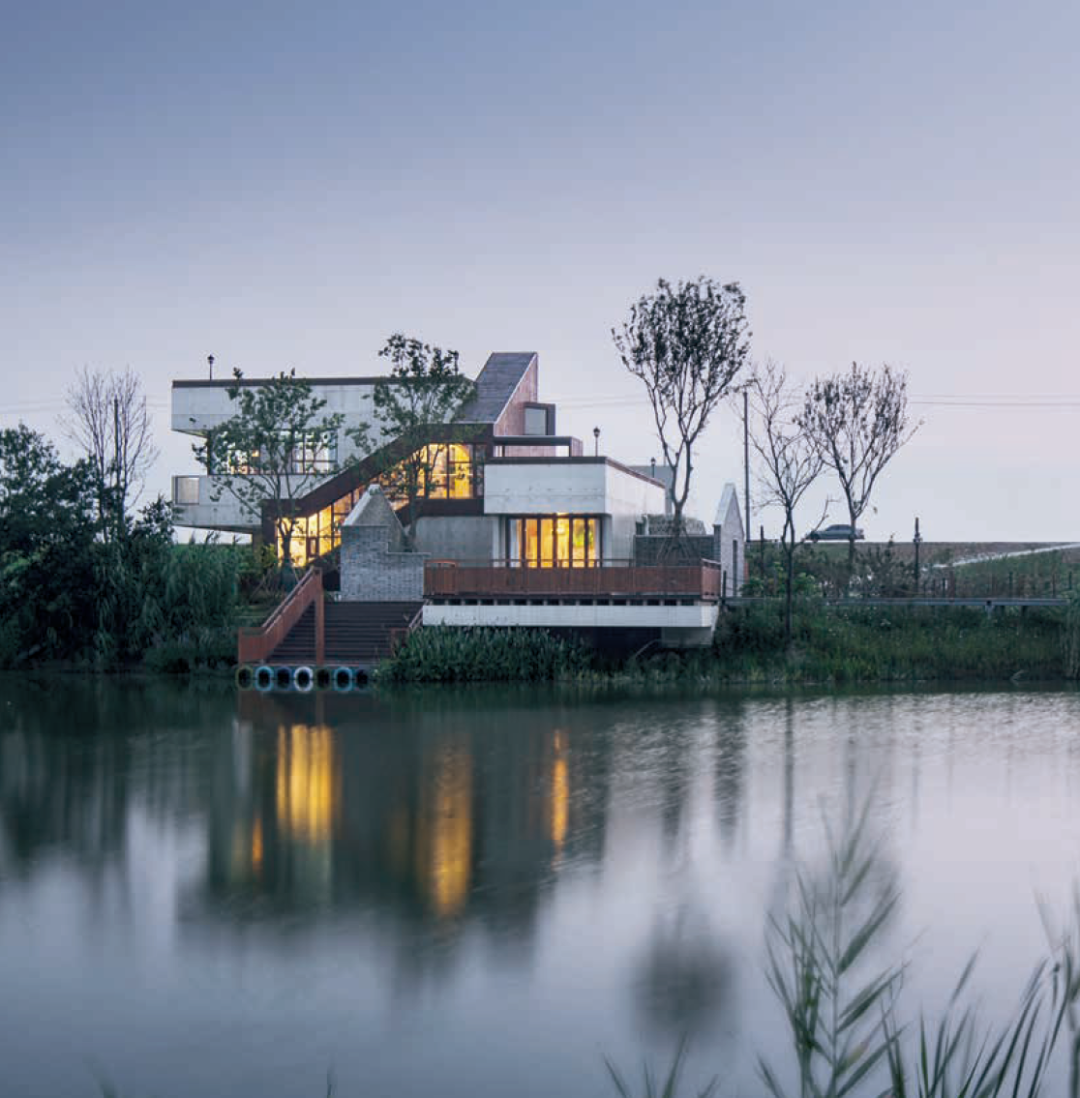
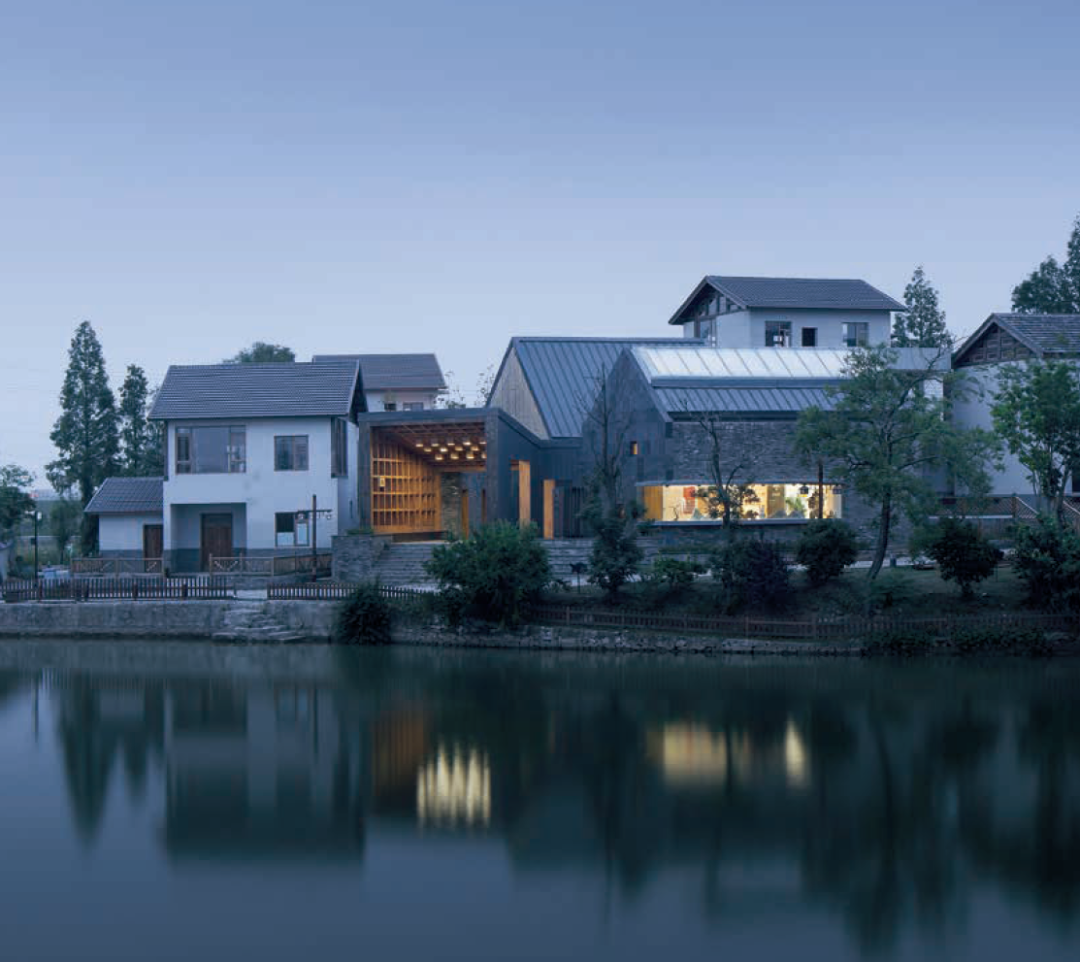
The water-front bar and village library in Qianjiadu Village, Jiangsu Province. Designed by the team from the School of Architecture at Southeast University. © School of Architecture, Southeast University.
Undoubtedly, the construction of unique leisure buildings in picturesque rural areas is a viable attempt to attract tourists and increase village revenue, especially when financial resources and investments are abundant. However, it is crucial not to overlook the starting point of rural residents' use and viewing of public buildings in the village. Buildings with a petite-bourgeois style have a natural cultural conflict with agricultural life. While rural buildings certainly need diversified functions, the extraction and summary of these functions cannot simply be borrowed from the urban architectural typology database. Instead, they should be concluded based on real-life scenarios in the countryside. While Cafés and libraries may exist in the countryside, more crucially, community activity rooms, chess rooms, conference halls, and public sun-drying grounds are needed. Only by starting from the actual needs of rural residents can more cultural and recreational functions find their place and usefulness. On the other hand, in the foreseeable future, when rural life generates new attractions and more people are willing to settle in the countryside, those functions that have a life atmosphere can evolve naturally and integrate into the normal life of rural residents.
3.The Dreams of Nostalgia and the Illusions of Foreign Land
One common approach to rural development is to transform rural areas into "Farmhouse Resorts"(农家乐)⑦ or “Themed Towns”. These towns often combine various attributes, such as tourism, catering, commerce, and real estate, to appeal to the inherent nostalgia of urban dwellers for rural life. With the saturated urban landscape of towering skyscrapers, urbanites are drawn to these towns during holidays and festivals to experience a simpler lifestyle that is closer to nature and free from the pressures of the city.
After witnessing the great success of certain Themed Towns, various village and town governments have rushed to imitate them, only to meet with failure. The underlying reason is not difficult to comprehend: if all Themed Towns adopt the same form - including architectural style, spatial layout, and business distribution - they lose their purported distinctiveness, . Unless imbued with genuine local folk customs, the urbanites' dreams of rural nostalgia will quickly dissipate.
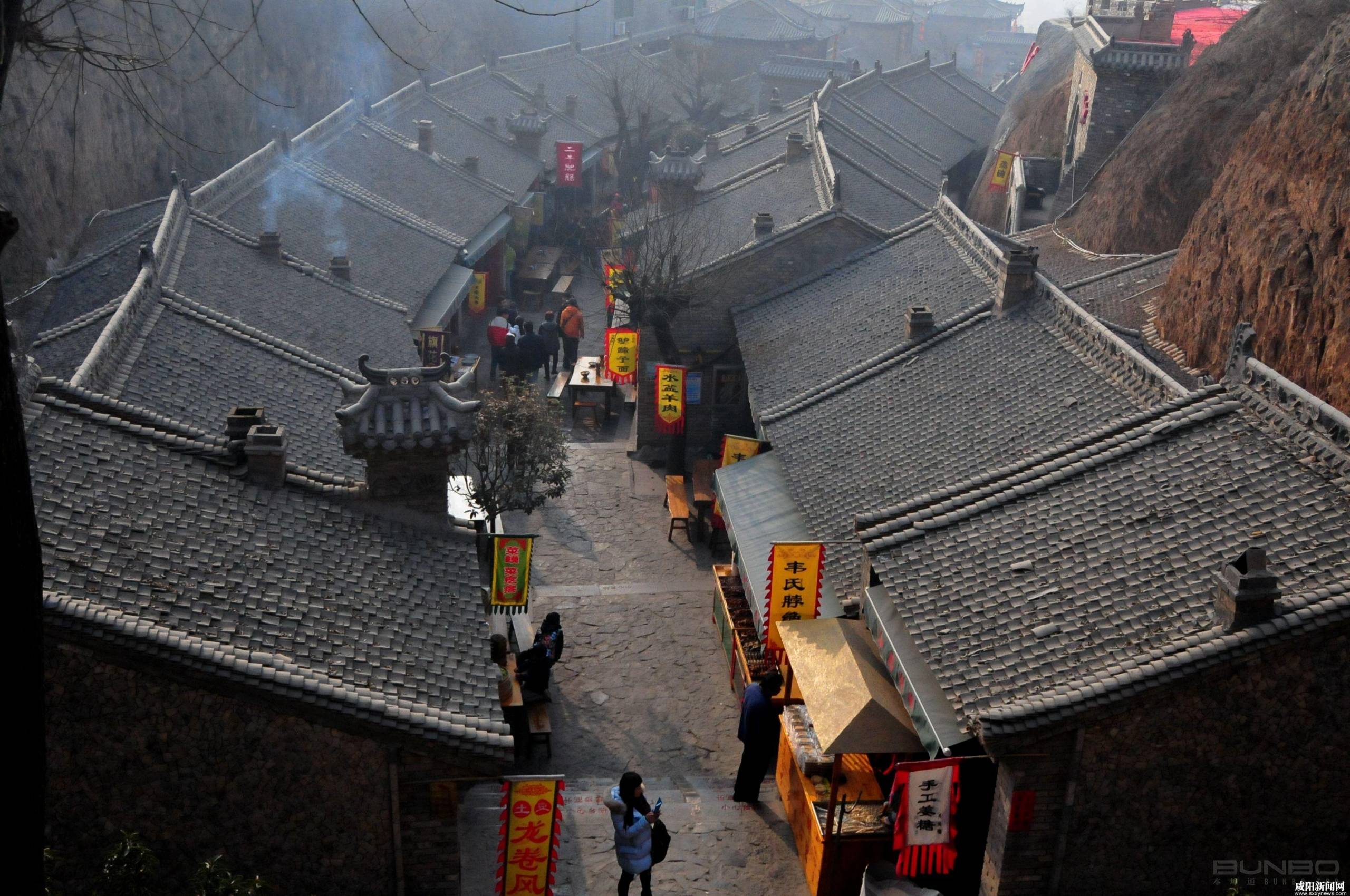
The Themed Town of Yuanjiacun Village in Shanxi Province has achieved tremendous success, leading to countless imitators. © Internet
The European-style Towns, on the other hand, represent purely residential real estate development. Real estate developers attempt to attract buyers with European-style and luxury estate concepts, building clusters of villas in rural and suburban areas that resemble European mansions, creating an illusion of foreign land. Today, a large number of such constructions have become unfinished buildings and vacant houses due to bad debts and poor sales, becoming abandoned lands that are far from the city and unsuitable for rural use.
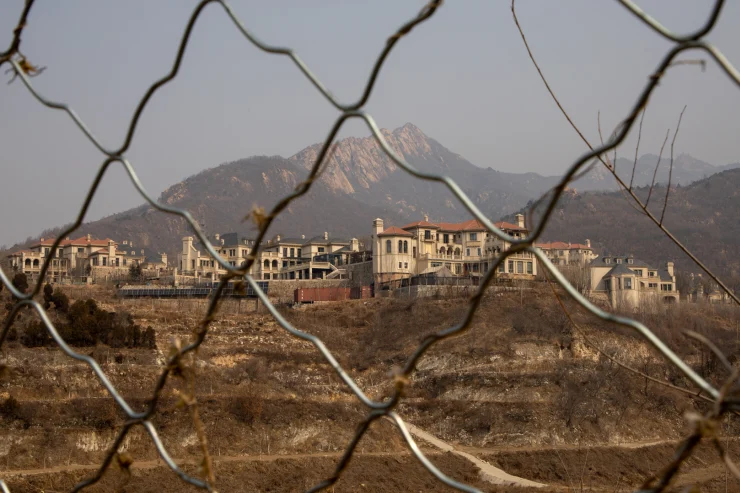
The vacant luxurious villa in Tianjiatun Village, Tianjin © Sangehee Liu
In retrospect, the failure of rural development attempts rooted in either the dreamy nostalgia or an idealized notion of foreign lands has made it clear that market-oriented solutions are insufficient. Such solutions do not address the actual needs and conditions of rural areas but instead create contrived experiential scenes. As mentioned previously, each rural area possesses unique characteristics that may serve as natural advantages, such as proximity to a lake or mountain range, distinctive crops, or local folk traditions. Thus, enhancing and expanding upon these features could be the starting point for stimulating interest in rural areas. Regardless of how extravagant the exterior design may be, it cannot mask the emptiness of a poorly considered concept.
4.The Ineffective Architectural Techniques
The concept of "vernacular" architecture was first proposed by the western architectural historian Bernard Rudofsky in his book "Architecture without Architects" in the 1960s. In addition to "vernacular architecture," he also introduced the concepts of "anonymous," "spontaneous," and "indigenous" architecture. [4] As the title suggests, one of the defining characteristics of these types of architecture is that they are "without architects," meaning that they lack strong top-down planning and intervention compared to urban areas, resulting in a state of "spontaneous connection" in terms of form and organization. Specifically, the local construction methods in rural areas are often based on long-standing experience and passed down through generations, as well as being influenced by constantly changing practical factors, leading to complex settlement forms(聚落). As a result, many of the mature techniques and concepts in traditional architecture will become ineffective in the face of such complexity.
For instance, traditional architectural thinking on individual buildings often begins with site analysis, which involves responding to the surrounding environment, analyzing the relationship between neighboring buildings, and integrating public and private spaces. Following site analysis, architects typically proceed to relatively straightforward design of individual buildings. However, in rural areas, site analysis of this kind may not be sufficient, as the properties of rural settlements dictate closer connections between buildings, making them more susceptible to the “domino effect.” It can be said that if architects attempt to build landmark projects in rural areas or create distinctive buildings without disturbing the status of surrounding settlements, they often end up producing a somewhat abrupt sense of foreignness. This is not a problem with the architect's design ability, but rather a result of the strong cohesive nature of rural settlements.
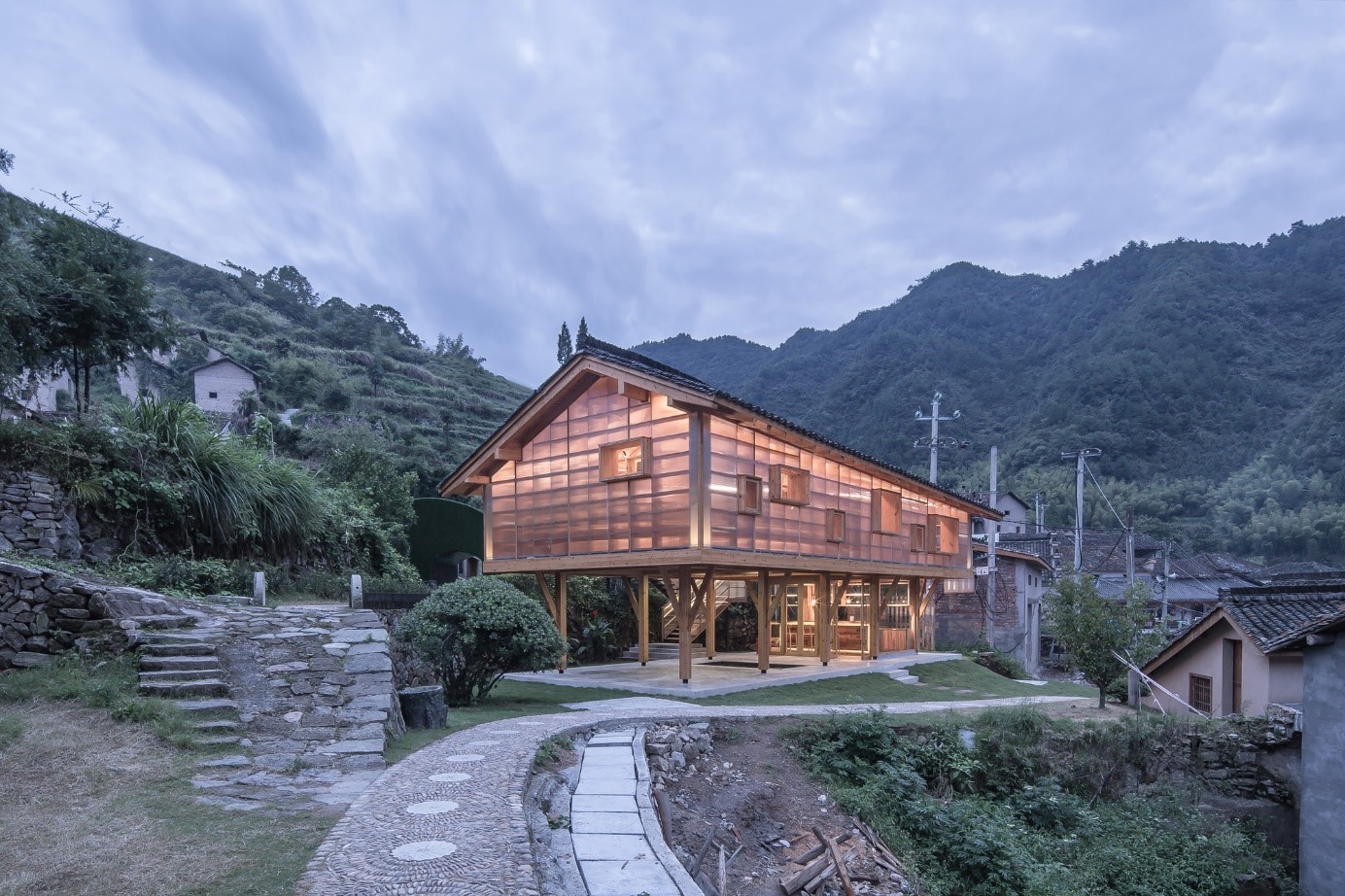
Mountain House in Mist, designed by Shulin Architectural Design, is a library located in a historic mountainous village in Wuyi County, Jinhua, Zhejiang Province © Zhao Yilong, Chen Lin.
Considering settlement patterns provides insight into the potential for comprehensive transformation in rural areas, exceeding the traditional architectural perspective. In "Countryside: A Report", Rem Koolhaas documented Dongfeng Village in Xuzhou, Jiangsu Province, as an example of a village that has shifted from poverty to becoming a key production and supply hub for Taobao stores in just a few years, ultimately becoming a large rural "factory." [5] This type of village is ubiquitous in China, and the villagers' familiarity with the entire supply chain for specific types of goods enables them to share their experiences and become renowned as "furniture villages" or "lamp villages." The buildings in these villages have undergone complete transformations and serve as vital components of large-scale production and distribution systems. This transformation is rooted in settlement patterns and the interpersonal structures of the "acquaintance society" unique to each village. E-commerce has become a vital source of income for these rural communities, enabling them to retain local residents while also attracting workers from neighboring towns and villages. In this sense, the historical value created by these villages is undeniable, and they are leading a dynamic rural revolution experiment. The fate of these villages appears to be disconnected from the exploration of space and form in architecture, expanding the traditional definition of rural areas and rendering architecture silent in these contexts.
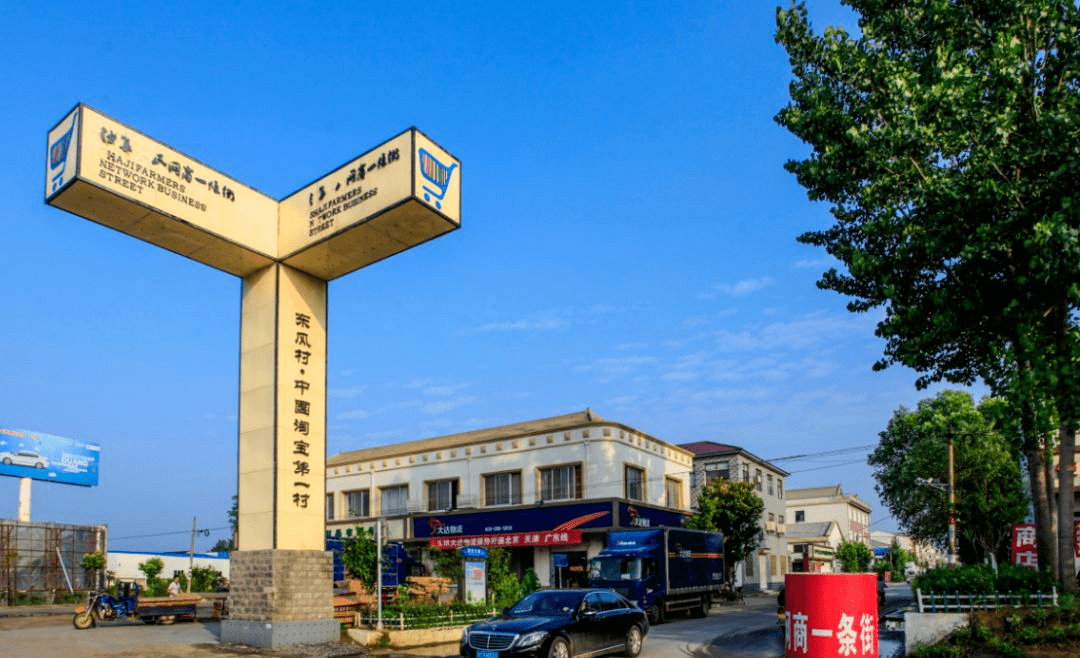
The entrance of Dongfeng Village © Internet
In recent years, there has been a growing trend in rural design projects that incorporate traditional Chinese cultural imagery. These projects often feature semantic characteristics found in ancient landscape paintings and the aesthetic preferences of elites. By utilizing rural sites, architects are able to depict the beauty of traditional culture, which is a viable approach to tracing the historical context of China. After all, in the rapidly developing urban centers, many authentic cultural imprints have been drowned out by waves of massive construction; Rural areas, with their slower pace of development, offer a chance to reclaim these imprints. However, it must be acknowledged that the cultural achievements excavated from architectural form and structure will ultimately remain at the level of imagery. True culture is deeply entwined with lifestyles and social forms. The cultural connotations that have been nearly exhausted in these rural areas face a dual pressure of meeting the demands of current economic development and the alienation of rural public aesthetics. Therefore, even if these experimental projects are delicate in their design and execution, their high complexity and low flexibility make them lack the capacity to accommodate the needs of rural architecture and fail to provide a solution to the stylistic dilemmas faced by rural building designs in a broader sense.
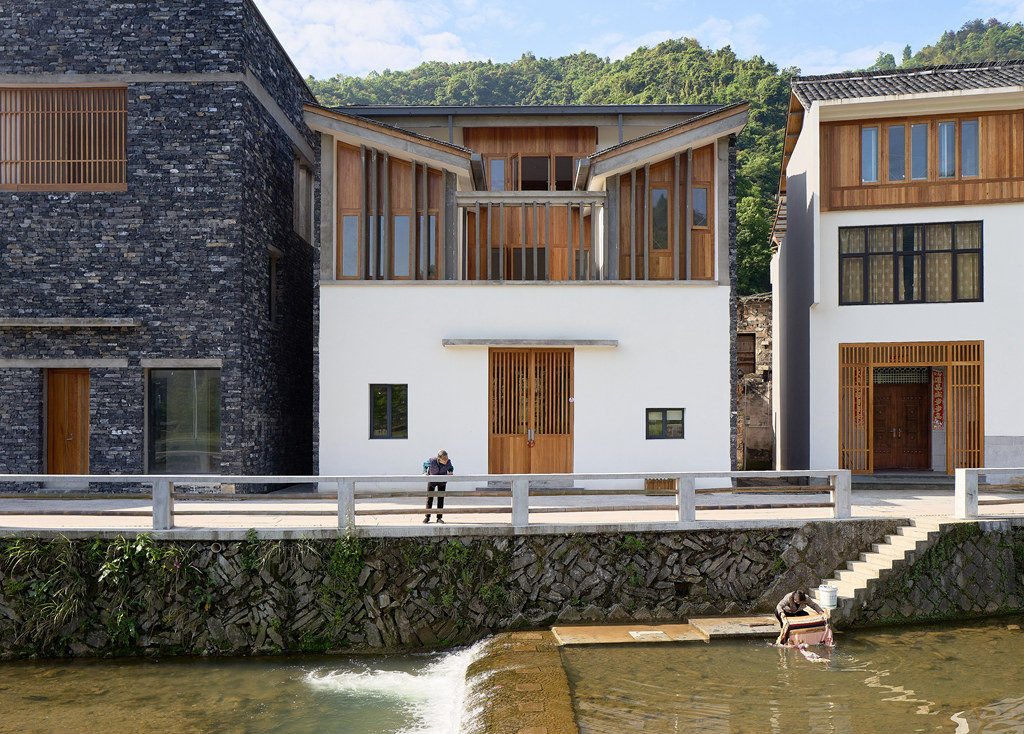
Wencun Village designed by Wang Shu and Lu Wenyu © zensic
Stepping back, why is it said that the aesthetic preferences of rural populations have undergone "alienation"? And why do rural architectures face "stylistic dilemmas"? It is easy to observe that many rural residents favor European-style villas, and are enamored with triangular pediment and Roman column - why has this aesthetic, which is not native to China, become a ubiquitous aspiration? In truth, this phenomenon is closely tied to the historical trajectory of urban-rural development.
China's experience of the Cultural Revolution and the subsequent era of Planned Economy ⑧ has exacerbated the urban-rural divide. During that time, the city was primarily seen as the hub of modern factories and workers - wherever there were factories, there was a city; wherever there weren't, there was a village. Thus, the city connoted development, while the village represented backwardness. This clear-cut dichotomy gradually made the ancient literati's idyllic rural life, as epitomized in the verse "leisurely viewing the southern mountains" (悠然见南山)⑨, despised by the times. Since the Reform and Opening-up policy ⑩ , the process of urbanization has continued to deepen, and urban life has increasingly been perceived as superior to rural life in terms of status and image. The old ideal of rural life has completely disintegrated, while a new and sufficiently attractive model of rural life has yet to emerge. "The City Makes Life Better"(城市让生活更美好)⑪ has not only become a slogan, but also a common belief among people - whether it is "better" or not, the city is where young rural people must go to strive for success. For a long time, a large number of bourgeoisie living in cities have used Western lifestyles as a symbol of taste and style. Rural people who have stayed in the city and have seen the luxurious European-style villas they reside in, have become psychologically assimilated. Therefore, when they return to their hometown, they tend to design their homes in the same way to prove their success. Thus, the "aesthetic alienation" and "stylistic dilemma" among the rural populace do not arise from their admiration of Western culture, but from the guidance and discipline provided by urban life in China. Within such a formed mindset, when architects attempt to persuade villagers to build buildings with the connotation of the literati's sentiments from the perspective of Chinese historical context and cultural ideals, they lack a solid foundation - if villagers cannot take such sentiments as their pride in their homes, then these sentiments become a kind of "cultural imposition". When Wang Shu communicated his design plans with the villagers of Wencun Village, he received the reply, "We don't want damp courtyards, we want to live in Western-style houses."
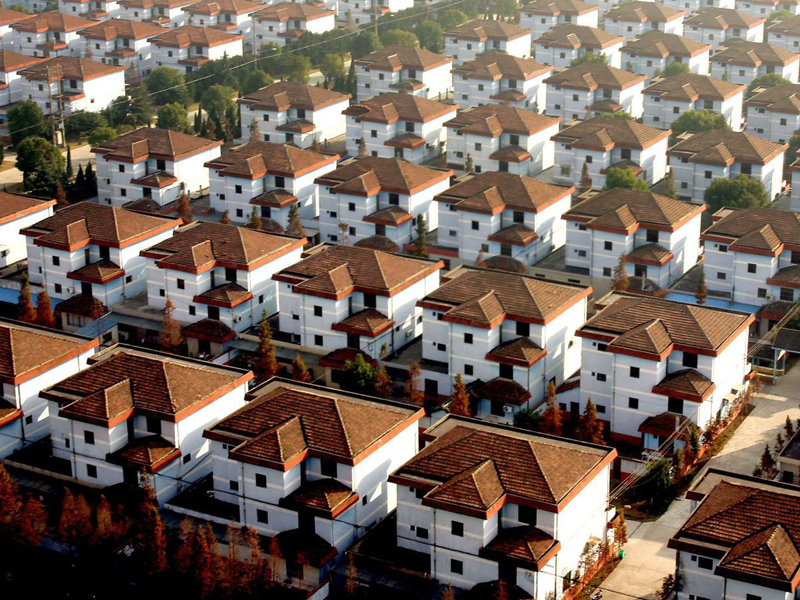
Huaxi Village, the wealthiest village in China, where every household owns a European-style villa © Internet
The inefficacy of architectural studies in rural areas also stems from the pressure placed on architects themselves. Regardless of whether the concept is based on traditional culture or contemporary architectural ideals, and even if the project in question is not rural in nature, many architects often panic at the prospect of their designs lacking a distinctive hallmark, as they fear their work will fall into the realm of mediocrity. However, rural architecture seems to inherently maintain a certain distance from such distinctiveness, as the humble agricultural culture displays a vastly different mode of expression from the clamorous urban culture. Nevertheless, it is important to acknowledge that the absence of a distinctive hallmark does not necessarily equate to mediocrity. Perhaps by relinquishing architectural stubbornness and genuinely seeking a strategy that combines the suitable living and working scenarios of rural areas, better design conclusions can be achieved. Only through such means can those cultural cores worthy of reformulation gradually be accepted by rural residents.
5.Composite Problems and Multi-dimensional Solutions
In many Western countries, rural development is another set of organized systems that is distinct from urban development. However, rural development in China is a compounded problem with Chinese characteristics. It involves a variety of factors, including historical evolution, economic systems, macro policies, land policies, and population structures, making it particularly complex and unpredictable. Because of its complexity, architects working in rural areas inevitably face a strong sense of "powerlessness" - The combination of opportunities and challenges is evident on these underdeveloped lands, where seizing opportunities means undertaking significant commitment and potential risks. Meanwhile, this sense of powerlessness also constitutes a rigorous assessment of the architect's comprehensive abilities: in rural China, architects assume roles far greater than those of mere designers, and focus more on coordinating and balancing multiple forces and interests to obtain the most stable equilibrium and most attractive solution.
In both urban and rural contexts, architects in China are facing a rapidly developing and constantly changing society, leaving them with little time for reflection and inadequate theoretical tools. The rationality of decisions can only be verified after the completion of construction, inevitably leading to many unsatisfactory outcomes. Thus, "foresight" in social development seems to be the most desired quality and ability for Chinese architects. Not to mention the additional difficulty presented by the COVID-19 pandemic and protean political situations, establishing "foresight" in a constantly changing social development state appears to be somewhat impractical.
Perhaps, the pursuit of "foresight" is not necessarily more constructive than focusing on the "present", as it can be confirmed that the composite problems in rural areas correspond to a multifaceted approach to solutions. The path to rural practice for architects may involve exploring the current characteristics and features of rural areas, utilizing them, and being prepared to start anew in the next work environment. Architecture alone cannot solve rural problems, but a multi-dimensional approach may enable architects to keep up with the pace of the times and awaken the still-vibrant potential of the countryside.
Reference
[1] “城中村”问题的形成与更新改造, 马星
[2] 大国之基:中国乡村振兴诸问题,贺雪峰
[3] 山东合村并居的真实情况, 吕德文
[4] 没有建筑师的建筑:简明非正统建筑导论(Architecture Without Architects: A Short Introduction to Non-Pedigreed Architecture),伯纳德·鲁道夫斯基(Bernard Rudofsky)
[5] 乡村,一份报告 (Countryside A Report),雷姆·库哈斯(Rem Koolhaas)
[6] 城乡社会:理解中国城乡关系的新概念, 熊万胜
[7] 王澍和他的乡村拯救行动, 徐琳玲
Glossary
① Urban Disease(城市病):Urban Disease refers to a set of problems that arise during the development of a city, such as traffic congestion, housing shortages, insufficient water supply, energy shortages, environmental pollution, disorderly conduct, and imbalanced material and energy flows. These issues are exacerbated by conflicting demands, leading to a worsening of the overall condition of the city.
② Desakotas(城乡结合部): Desakota is a term used in urban geography used to describe areas in the extended surroundings of large cities, in which urban and agricultural forms of land use and settlement coexist and are intensively intermingled. The term was coined by the urban researcher Terry McGee of the University of British Columbia around 1990. It comes from Indonesian desa "village" and kota "city".
③ Themed Towns(特色小镇): China's Themed Towns are a type of real estate development that combines cultural, tourism, residential, and industrial functions in a single location. These towns are often designed to reflect a particular theme, such as a historical era, cultural tradition, or natural landscape. The goal of Themed Towns is to promote economic development, boost tourism, and provide a unique living experience for residents. Themed Towns are a part of China's broader strategy to promote urbanization and rural revitalization.
④ Urban Villages(城中村): Urban Villages are villages that appear on both the outskirts and the downtown segments of major Chinese cities. They are surrounded by skyscrapers, transportation infrastructures, and other modern urban constructions. Urban villages are commonly inhabited by the poor and transient, and as such they are associated with squalor, overcrowding and social problems. However, they are also among the liveliest areas in some cities and are notable for affording economic opportunity to newcomers to the city.
⑤ Model Villages(模范村): China's model village refers to a development model aimed at improving the living standards and promoting rural development in China. It involves the construction of new houses, infrastructure facilities, and public spaces, as well as the provision of public services, such as education and healthcare, to the residents of the village. The model village aims to promote the development of the local economy, improve the quality of life for rural residents, and bridge the gap between urban and rural areas in China.
⑥ Village Consolidation(合村并居): Village Consolidation refers to a rural transformation policy that was implemented by Shandong Province, China, in 2019. The main contents of this policy include the demolition of farmers' houses, the consolidation of original villages, and the establishment of new rural communities, where farmers can live in multi-story buildings. The policy of consolidating villages and relocating residents has been controversial due to its sudden implementation, opposition from local residents, and causing financial burden on families, harassing villagers, and resorting to coercion. The Shandong Provincial Government also referred to this policy as "Optimizing Village Layout"(优化村庄布局)or "Building Beautiful and Livable Rural Areas"(建设美丽宜居乡村).
⑦ Farmhouse Resorts(农家乐): Farmhouse resorts in China are a type of rural tourism destination where visitors can experience traditional Chinese rural life, enjoy farm-to-table dining, and participate in agricultural activities such as picking fruits and vegetables or caring for livestock. These resorts often feature renovated or newly-built traditional farmhouses as accommodation options, along with amenities such as swimming pools, hot springs, and spa services. Farmhouse resorts have become increasingly popular in China as urban residents seek to escape the city and experience a slower pace of life in the countryside.
⑧ Planned Economy (计划经济): Planned Economy refers to the economic system that was in place in China from the establishment of the People's Republic of China in 1949 until the initiation of economic reforms in the late 1970s. Under the planned economy, the state controlled most aspects of the economy, including production, distribution, and pricing of goods and services. The government set production targets and allocated resources accordingly, with the goal of developing heavy industry and infrastructure. The planned economy was characterized by a lack of market mechanisms and private enterprise, with all economic activity being directed and controlled by the state.
⑨ “leisurely viewing the southern mountains”(悠然见南山): The verse "悠然见南山" is from a famous poem by Tao Yuanming, a Chinese poet from the Jin Dynasty. It is often translated as "Leisurely I gaze upon the southern mountains". In this verse, "悠然" (yōu rán) means "leisurely" or "carefree", "见" (jiàn) means "to see" or "to look at", and "南山" (nán shān) means "southern mountains". The verse reflects Tao's love of nature and his desire for a simple and untroubled life, free from the constraints and worries of society. It has become a symbol of the ideal of living in harmony with nature and embracing a simple, peaceful existence.
⑩ Reform and Opening-up Policy(改革开放): The Reform and Opening-up Policy is a series of economic and social reforms launched in 1978 by the Chinese government under the leadership of Deng Xiaoping. The policy aimed to modernize China's economy and society by opening up to the outside world, attracting foreign investment, and introducing market-oriented reforms to replace the previously planned economy. The reforms included measures such as agricultural decollectivization, the establishment of special economic zones, the encouragement of foreign trade and investment, the privatization of state-owned enterprises, and the promotion of technological innovation. The policy has been widely regarded as a major turning point in China's economic and social development, leading to rapid economic growth and a dramatic improvement in living standards for the Chinese people.
⑪ "The City Makes Life Better"(城市让生活更美好): "The City Makes Life Better" is a slogan coined by the Chinese government to emphasize the importance of urban development and its role in improving people's quality of life. The slogan has been used to promote various urbanization policies and initiatives aimed at improving the living standards of Chinese citizens, such as the development of smart cities, public transportation systems, green spaces, and affordable housing. It reflects the government's belief that the urbanization process can bring significant social and economic benefits to the country, and has become a widely recognized catchphrase in China's urban planning and development discourse.



